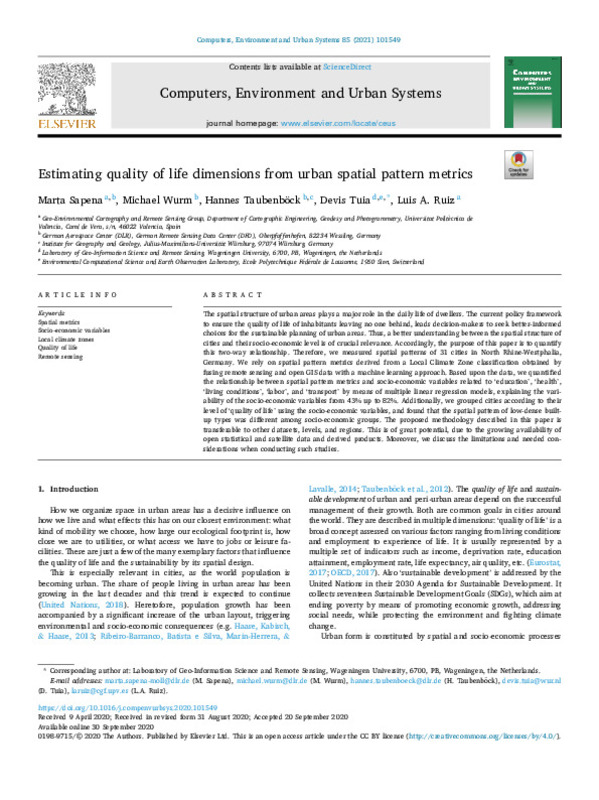JavaScript is disabled for your browser. Some features of this site may not work without it.
Buscar en RiuNet
Listar
Mi cuenta
Estadísticas
Ayuda RiuNet
Admin. UPV
Estimating quality of life dimensions from urban spatial pattern metrics
Mostrar el registro sencillo del ítem
Ficheros en el ítem
| dc.contributor.author | Sapena, Marta
|
es_ES |
| dc.contributor.author | Wurm, Michael
|
es_ES |
| dc.contributor.author | Taubenböck, Hannes
|
es_ES |
| dc.contributor.author | Tuia, Devis
|
es_ES |
| dc.contributor.author | Ruiz Fernández, Luis Ángel
|
es_ES |
| dc.date.accessioned | 2022-07-08T18:05:13Z | |
| dc.date.available | 2022-07-08T18:05:13Z | |
| dc.date.issued | 2021-01 | es_ES |
| dc.identifier.issn | 0198-9715 | es_ES |
| dc.identifier.uri | http://hdl.handle.net/10251/183992 | |
| dc.description.abstract | [EN] The spatial structure of urban areas plays a major role in the daily life of dwellers. The current policy framework to ensure the quality of life of inhabitants leaving no one behind, leads decision-makers to seek better-informed choices for the sustainable planning of urban areas. Thus, a better understanding between the spatial structure of cities and their socio-economic level is of crucial relevance. Accordingly, the purpose of this paper is to quantify this two-way relationship. Therefore, we measured spatial patterns of 31 cities in North Rhine-Westphalia, Germany. We rely on spatial pattern metrics derived from a Local Climate Zone classification obtained by fusing remote sensing and open GIS data with a machine learning approach. Based upon the data, we quantified the relationship between spatial pattern metrics and socio-economic variables related to `education¿, `health¿, `living conditions¿, `labor¿, and `transport¿ by means of multiple linear regression models, explaining the variability of the socio-economic variables from 43% up to 82%. Additionally, we grouped cities according to their level of `quality of life¿ using the socio-economic variables, and found that the spatial pattern of low-dense built-up types was different among socio-economic groups. The proposed methodology described in this paper is transferable to other datasets, levels, and regions. This is of great potential, due to the growing availability of open statistical and satellite data and derived products. Moreover, we discuss the limitations and needed considerations when conducting such studies. | es_ES |
| dc.description.sponsorship | This research has been partially funded by the Spanish Ministerio de Economia y Competitividad and European Regional Development Fund (CGL2016-80705-R) and by the Swiss National Science Foundation (PP00P2-150593). | es_ES |
| dc.language | Inglés | es_ES |
| dc.publisher | Elsevier | es_ES |
| dc.relation.ispartof | Computers Environment and Urban Systems | es_ES |
| dc.rights | Reconocimiento (by) | es_ES |
| dc.subject | Spatial metrics | es_ES |
| dc.subject | Socio-economic variables | es_ES |
| dc.subject | Local climate zones | es_ES |
| dc.subject | Quality of life | es_ES |
| dc.subject | Remote sensing | es_ES |
| dc.subject.classification | INGENIERIA CARTOGRAFICA, GEODESIA Y FOTOGRAMETRIA | es_ES |
| dc.title | Estimating quality of life dimensions from urban spatial pattern metrics | es_ES |
| dc.type | Artículo | es_ES |
| dc.identifier.doi | 10.1016/j.compenvurbsys.2020.101549 | es_ES |
| dc.relation.projectID | info:eu-repo/grantAgreement/SNSF//PP00P2-150593/ | es_ES |
| dc.relation.projectID | info:eu-repo/grantAgreement/AEI//CGL2016-80705-R//ANALISIS Y VALIDACION DE PARAMETROS DE ESTRUCTURA FORESTAL DERIVADOS DE LIDAR Y OTRAS TECNICAS EMERGENTES Y SU INCIDENCIA EN LA MODELIZACION DEL POTENCIAL COMBUSTIBLE/ | es_ES |
| dc.rights.accessRights | Abierto | es_ES |
| dc.contributor.affiliation | Universitat Politècnica de València. Departamento de Ingeniería Cartográfica Geodesia y Fotogrametría - Departament d'Enginyeria Cartogràfica, Geodèsia i Fotogrametria | es_ES |
| dc.description.bibliographicCitation | Sapena, M.; Wurm, M.; Taubenböck, H.; Tuia, D.; Ruiz Fernández, LÁ. (2021). Estimating quality of life dimensions from urban spatial pattern metrics. Computers Environment and Urban Systems. 85:1-11. https://doi.org/10.1016/j.compenvurbsys.2020.101549 | es_ES |
| dc.description.accrualMethod | S | es_ES |
| dc.relation.publisherversion | https://doi.org/10.1016/j.compenvurbsys.2020.101549 | es_ES |
| dc.description.upvformatpinicio | 1 | es_ES |
| dc.description.upvformatpfin | 11 | es_ES |
| dc.type.version | info:eu-repo/semantics/publishedVersion | es_ES |
| dc.description.volume | 85 | es_ES |
| dc.relation.pasarela | S\418803 | es_ES |
| dc.contributor.funder | Agencia Estatal de Investigación | es_ES |
| dc.contributor.funder | Swiss National Science Foundation | es_ES |
| dc.contributor.funder | European Regional Development Fund | es_ES |
| dc.subject.ods | 11.- Conseguir que las ciudades y los asentamientos humanos sean inclusivos, seguros, resilientes y sostenibles | es_ES |








